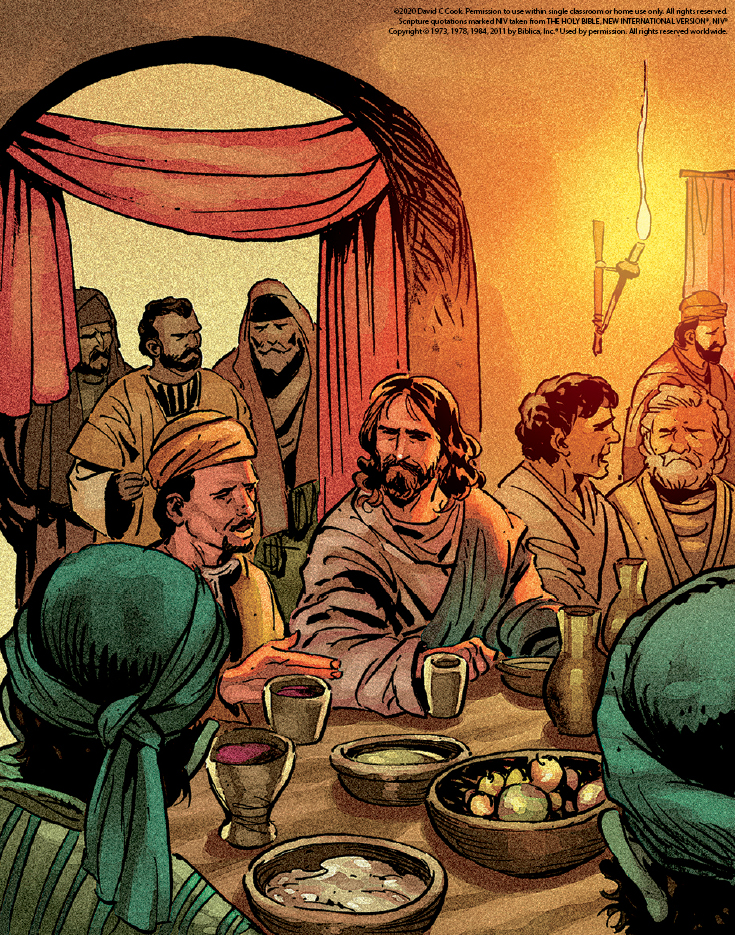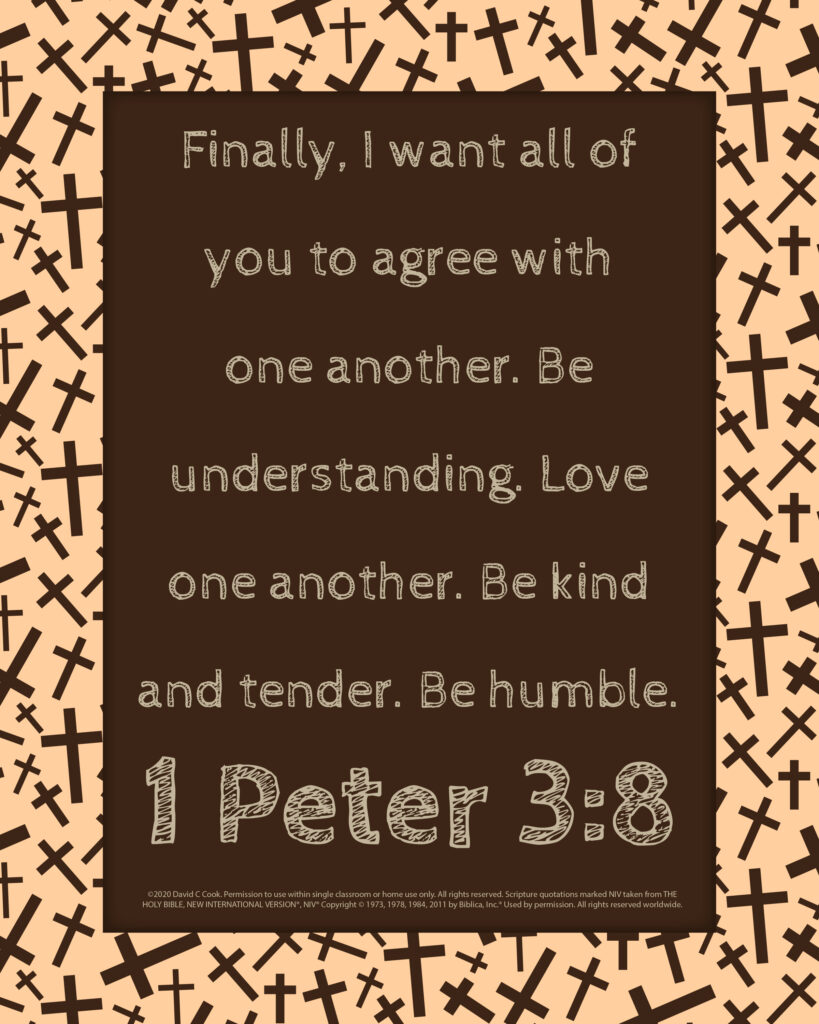During the lesson, the information for you to know is written in regular type, and what we suggest speaking or reading aloud to children is in bold. All resources for this lesson, including the Teacher Guide, Student Page, Family Connection Card, and other resources can be downloaded in a ZIP file by clicking on the following link:
In some lessons you will find "resource articles." These are articles written by experts from around the world to help equip you for your work with children and adolescents. Share them with parents or guardians if you consider it appropriate.
Before class, place the small stones around your teaching space. Try to place them in areas where the children cannot easily see the stones but can still reach them.
But here is what I tell you who are listening. Love your enemies. Do good to those who hate you. Bless those who call down curses on you. And pray for those who treat you badly.
Luke 6:27–28
Jesus showed us by His example what it means to truly love. He taught us that love means caring for others, forgiving those who have hurt us, and thinking more of others than of ourselves. This love is not simple kindness or courtesy. It is an active choice to love in self-sacrificing ways, even when it is difficult. This kind of love is radical and life-changing—in fact, this kind of love has the power to change the world!
Ask God to bring to mind a difficult relationship where you need to show love. Ask Him to guide you to His best for that relationship. Allow Him to soften your heart and heal your wounds so that you can begin to love that person as He desires. Then reach out in love and do good. Invite God to work in you and through you as you show love in self-sacrificing ways. Whether or not you experience transformation in that relationship, you will experience transformation in your heart. God, the source of all love, does amazing things in and around us even when we feel undeserving of His love.
Encourage families to talk about ways they can honour and love those who are unkind and difficult to love. Ask that families consider some people in the community who may not be liked because of their jobs. What is the value in treating these people with kindness?
Teacher Tip: If possible, email or text the Family Connection Card to the families of your students.
Greet the children as they arrive. When you are ready to begin, have them sit in their regular places to hear the instructions for the activity.
I have placed some small stones around the teaching space. When I tell you to begin, you will find a stone, pick it up, and return to your place. You will only pick up 1 stone.
How many stones will you pick up?
One stone.
Ready? Go!
Give the children 1–2 minutes to find the stones and return to their normal places.
These stones may not look like much, but we will pretend they are love. Love is very important and valuable. Now, you will decide what to do with your stones. You may either choose to give your “love” to someone you care about, or you can put it down at the front of the teaching space. These are your only choices. Raise your hand when you know what you want to do with your stone.
If needed, repeat the options to the children. Once most or all of the children are raising their hands, allow them to put their stones down or give them to other children. Once the children have completed the task, ask them to return to their normal places.
As we have talked about, love is made for sharing. So many of you chose to share your love with someone else. When we show love to others, we honour God and we show others who He is. God is love.
Take the stones from the front of the class and give them to the children who do not have stones.
Now, if we pretend that these stones represent love, you have another decision to make. You can either give your stone to people who have been unkind to you and who you do not like to spend time with, or you can place them at the front of our space.
When I invited you to give love to someone you cared about, it may have been easy for you to give it to someone. But when I told you the only people you could share your love with were people who had hurt you or people you did not like, it might have been more difficult for you to give your stones to someone.
Allow the children to keep their stones so they have them for another activity later in the lesson. Ask the children to place their stones out in front of them so they will not be tempted to play with the stones as you teach.
It is difficult to try to love people who have been unkind to you or who you just do not like to spend time with. However, the Bible teaches us that we need to love everyone, even the people who are difficult for us to love. Today we will learn more about how to love others when it is difficult.
What does it mean to love others?
Allow 2–3 children to respond.
The Bible teaches us that love is more than simply being kind to those who are kind to us. Listen to what the Bible says about what it means to love others.
If possible, read these verses directly from your Bible.
Love is patient. Love is kind. It does not want what belongs to others. It does not brag. It is not proud. It does not dishonor other people. It does not look out for its own interests. It does not easily become angry. It does not keep track of other people’s wrongs.
1 Corinthians 13:4–5
Who can name 1 thing these verses say about what love is?
Allow 2–3 children to respond. If needed, you may repeat the verses so they can listen for the answers to the question. Possible answers include: patient, kind, not bragging, humble or not proud, honouring to others, unselfish, not easily angered, and forgiving.
It can be difficult to love others this way! It is difficult to be patient when someone makes us feel angry. It is difficult to forgive when someone has hurt us. It is difficult to think of what other people may want and need when they have not treated us well.
Do you think we need to love those who are unkind to us? Why or why not?
Allow 2–3 children to respond.
Loving others is sometimes difficult for us. However, during His time on earth, Jesus gave us many examples of how we are to love others. He showed love to everyone, even people who were not liked by those in their communities.
In a moment, I will tell you a true story from the Bible about Jesus’ love for someone who others did not like. Before I do, I will need 4 volunteers.
Choose 4 children to help you. Ask these children to stand with you. Assign 1 child to pretend to be Matthew and the rest to be the dinner guests at Matthew’s home. If possible, place a chair or stool at the front of the teaching space. This will be Matthew’s tax collector’s station. Allow the other volunteers to sit near “Matthew.”
Optional: If possible, share the images from The Action Bible.


As I tell this story, we will act it out. Those of you who are not standing here with me will be the villagers. Ready? Let’s listen to the true story from the Bible about Jesus and Matthew.
Matthew was a tax collector. He collected money from the Jewish people to give to the Roman government. Most tax collectors at this time cheated people to make themselves rich. Most people in his village probably hated Matthew.
Ask the class to pretend to look angry. Then, ask them to take their stones and line up where Matthew is standing.
The villagers came to Matthew’s tax collector’s station to pay their taxes. People did not like to pay taxes because it meant they would not have as much money to feed their families and buy other things they needed.
Each of you will gently give Matthew your stones and go sit in your normal places.
Have the children who are villagers walk past Matthew’s tax collector’s station and gently give the child pretending to be Matthew their stones. Encourage them to look angry or sad as they give their stones. Leave the stones in a pile near the tax collector’s station.
Matthew collected lots of money from the people in the village. One day, when he was sitting in his tax collector’s station collecting money, Jesus came by.
You will pretend to be Jesus. Walk up to Matthew’s station.
Jesus said, “Follow me.” So Matthew stood up and followed Jesus.
Have the child who is pretending to be Matthew stand up. Then lead him to a place away from his tax collector’s station. Remain standing with “Matthew.”
Jesus chose Matthew to be His disciple! Remember, a disciple is someone who knows and follows Jesus. Matthew would become one of Jesus’ good friends.
Allow 2–3 children to respond to each of the following questions.
We do not know why Jesus chose Matthew. Whatever His reason for choosing Matthew, Jesus chose him even though other people did not like tax collectors. Later, Jesus had dinner at Matthew’s house. Many tax collectors and other people came. They ate with Jesus and the disciples.
Ask all 4 of the children who volunteered to act with you to sit with you in a circle at the front of the class and pretend to eat. Then stand up.
Jesus had dinner with a whole group of people that would not have been liked by others in their community. He showed love and kindness toward them when others might not have done this. This is the way Jesus wants us to live. Listen to what Jesus told His disciples:
Love your enemies. Do good to those who hate you. Bless those who call down curses on you. And pray for those who treat you badly.
Luke 6:27–28
Why do you think Jesus would tell His followers to love their enemies?
Allow 2–3 children to respond.
It is very difficult to love our enemies. Enemies are people who are unkind, hurtful, and very difficult to be around. Jesus wants us to pray for these people and to do good to them. Let’s talk about what this might look like.
When you do these things, you may think that the other person will now be kind or loving in return. However, that may not happen! We do not love our enemies only if they will change. We love them because God has told us to do that.
Have the children find partners for the following activity. If needed, you may have 1 group of 3 children.
I will name some ways we can show love to someone we struggle to love. When I call the way you will use to love the person you thought of, you will come to the front of our space and pick up a stone. You will then return to where you are sitting.
Name the following ways to show love:
Another way you thought of to show love to them.
You may keep your stone somewhere you will see it often. This will be a reminder to show love to the person you thought of. When we need to show love in a difficult situation, we can ask God for help because He is love. Let’s pray for the people in our lives who we struggle to love. I will pause during the prayer so you can talk to God about your situation quietly or in your thoughts. Then we will close our prayer together.
Lord, help me to love others the way You do. Give me strength to show love even when it is difficult. Show me how You want me to show love to this person who is difficult for me to love.
Pause for 30 seconds to allow the children to pray for the people they struggle to love.
Thank You for being a loving God who teaches me how to love. Help me to show love to others, even when it is difficult. In Jesus’ name, amen.
You did a great job of showing love, even when it was difficult. Loving our enemies and others who are unkind to us can be difficult. Sometimes we show love and do not receive love in return. Sometimes we have to show courage and love people who are not loved by others.
Optional: If you are using Student Pages, give the children crayons and allow 2–3 minutes for them to complete their pages.

As you leave today, remember to pray for those who are difficult for you to love. God can help you to show love to these people. Our memory verse this week reminds us of ways we can love others, even those who are difficult to love.
If you are using the Memory Verse Poster, show it to the students.
Finally, I want all of you to agree with one another. Be understanding. Love one another. Be kind and tender. Be humble.
1 Peter 3:8

Review the song, rhythm, or chant you created to help the children remember the memory verse. If possible, encourage the children to make hearts with their hands throughout the song when they say ways a person can share love with others.
Review the memory verse song or chant 3 times. Then end class by saying this blessing, based on Luke 6:27–28, over the children.
Blessing: May you allow God to guide you as you show love to others, even those who have hurt you. May your love for others bless those around you.
Lead the children in singing this quarter’s song, if possible.
Life on Life ©2020 David C Cook. Reproducible for home or classroom use only. All other uses require written permission from David C Cook [email protected]. All rights reserved.